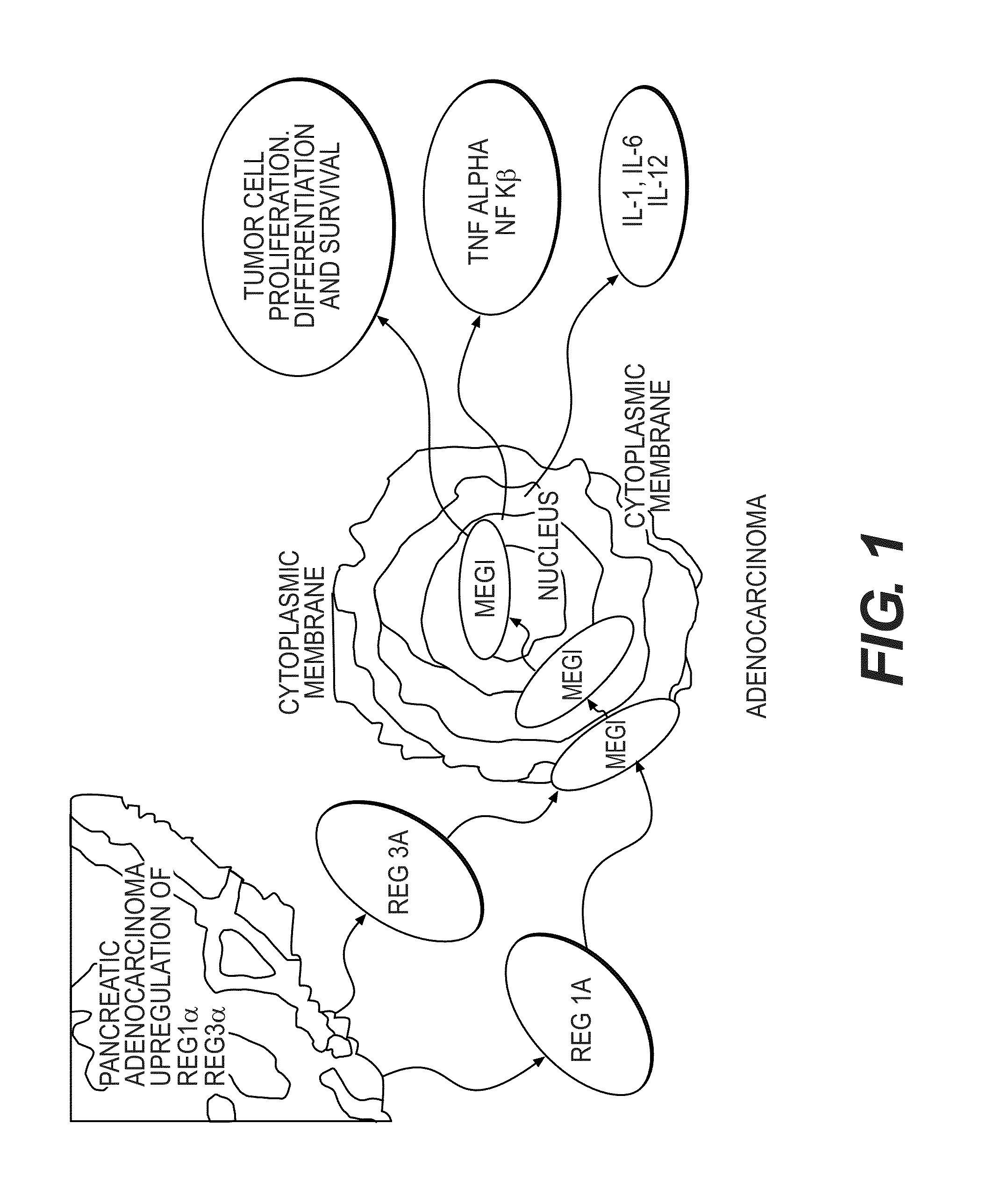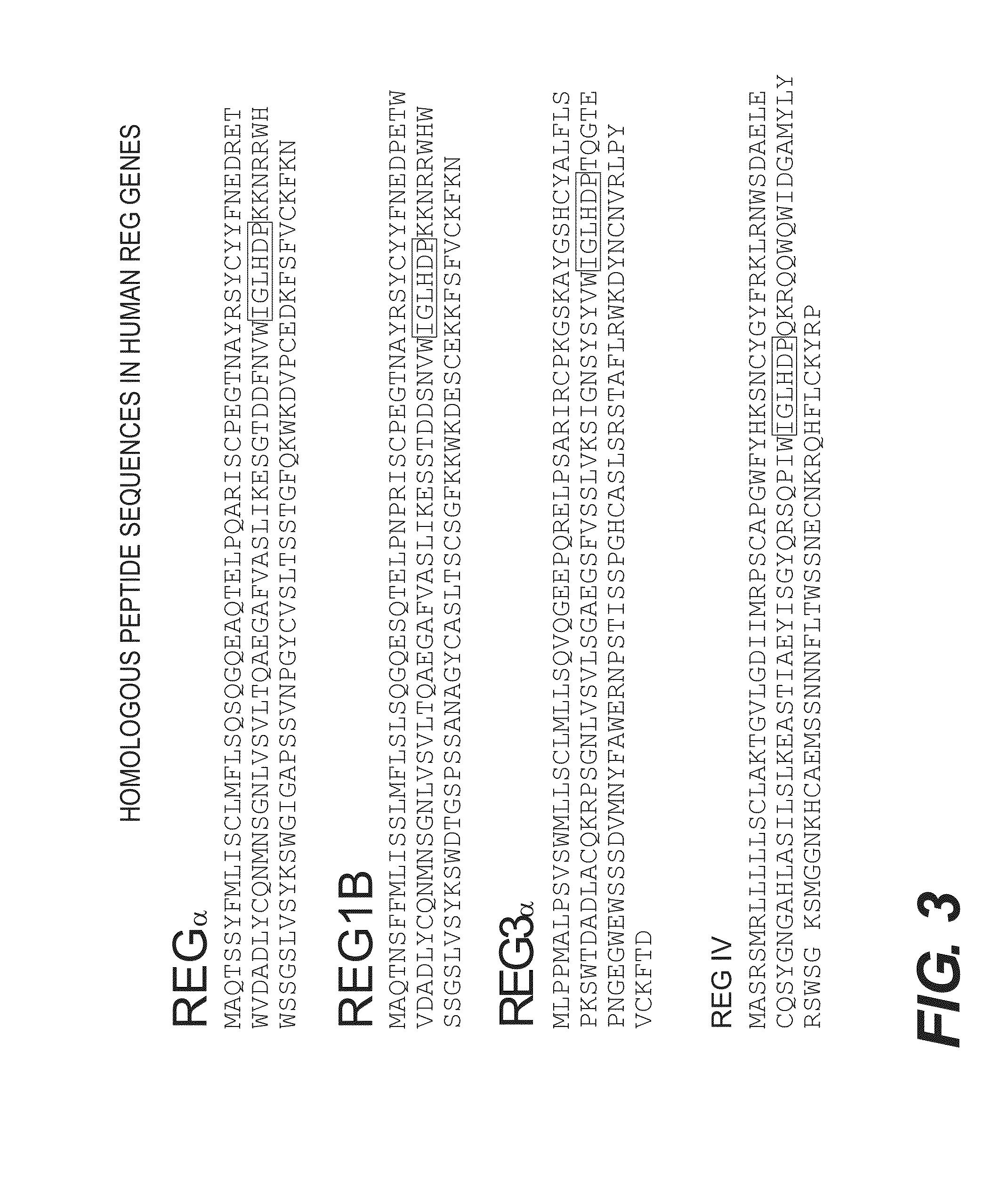Early Diagnosis and Novel Treatment of Cancer
a cancer and tumor cell technology, applied in the field of early diagnosis and novel treatment of cancer, can solve the problems of reduced tumor cell growth and expression, and limited tumor cell expression, and achieve the effect of reducing the size of tumors
- Summary
- Abstract
- Description
- Claims
- Application Information
AI Technical Summary
Benefits of technology
Problems solved by technology
Method used
Image
Examples
example 1
Determining the Presence of Megi on Adenocarcinoma of the Pancreas
[0090]The primary candidate protein to potentially to rate-limiting in adenocarcinoma of the pancreas was identified as Megi (FIG. 5). This investigation was undertaken to determine if Megi was present on adenocarcinoma of pancreas and whether Reg peptide modulates expression of Megi and subcellular localization. There has been no previous description of Human Hereditary Multiple Exostoses Isolog gene protein (Megi) specifically playing a role in adenocarcinoma. Megi was selected as a possible receptor on pancreatic tissue because it was found as a binding protein for Reg1 in rats (Kobayashi S., et al., J Biol Chem 2000, 275, 10723-10726).
[0091]This investigation was undertaken to determine if Human Hereditary Multiple Exostoses Isolog gene protein (Megi) was present on adenocarcinoma of pancreas and whether Reg peptide modulated expression and subcellular localization. The initial study evaluated the presence of Megi...
example 2
Megi as Reg Protein Receptor on Tumor Cells
[0094]Previous studies have found that Reg proteins are expressed and is a tumor marker in human cancer, but to date, Reg1α or Reg3α have been considered inflammatory makers and there has been no direct relationship made between Reg1α or Reg3α playing a role in tumor growth. Many teams have shown that Reg mRNA is undetectable in sera, pancreatic secretions and pancreatic tissue in normal healthy adults. No direct role of Reg1α or Reg3α has been shown to play in stimulating tumor cells or enhancing tumor cell growth, speed or downstream tumor pathways. These studies were undertaken to determine if the presence of Reg1α or Reg3α may impact its potential receptor (Megi) in pancreatic cancer cells and have an impact on cancer.
[0095]By evaluating the three-dimensional structures of Reg1α and Reg3α derived from the primary sequences and folded by SwissProt folding algorithms with the predicted three-dimensional structure of both peptides was simi...
example 3
Enhancement in Tumor Activity and Speed
[0098]Western blot analyses were utilized to evaluate and confirm the impact of Reg on Megi translocation from the cytoplasmic membrane, through the cytoplasm and to the nucleus and to determine if there was a measurable enhancement in tumor trafficking when Reg peptide is added to cancer cells.
[0099]The Western blot analysis of cytosolic and nuclear fractions isolated at the indicated time points with Reg peptide accelerating time of Megi translocation from the cell surface membrane to nucleus. Adenocarcinoma cells were seeded in T75 flasks in Dulbecco's Modified Eagle media containing 10% fetal bovine serum. The cells were incubated at 370 C, 5% CO2 for 24 hours and then treated with Reg peptide at the final concentration of 167 nM. This treatment was performed once a day for four days. On the fifth day the cells were broken to obtain the cell lysates. In these cell extracts the total protein levels were determined, and 50 micrograms of total...
PUM
| Property | Measurement | Unit |
|---|---|---|
| pH | aaaaa | aaaaa |
| pH | aaaaa | aaaaa |
| time | aaaaa | aaaaa |
Abstract
Description
Claims
Application Information
 Login to View More
Login to View More - R&D Engineer
- R&D Manager
- IP Professional
- Industry Leading Data Capabilities
- Powerful AI technology
- Patent DNA Extraction
Browse by: Latest US Patents, China's latest patents, Technical Efficacy Thesaurus, Application Domain, Technology Topic, Popular Technical Reports.
© 2024 PatSnap. All rights reserved.Legal|Privacy policy|Modern Slavery Act Transparency Statement|Sitemap|About US| Contact US: help@patsnap.com










